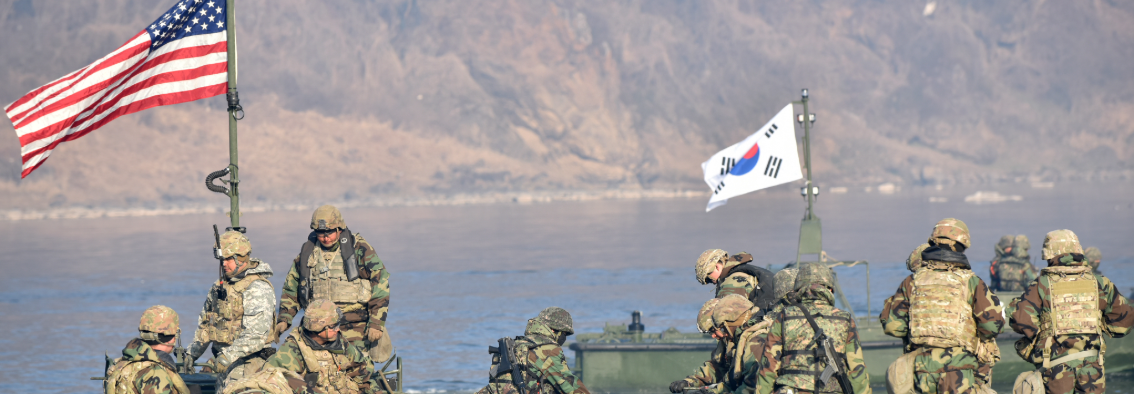As the People’s Republic of China (PRC) grows more aggressive towards Taiwan, American security analysts are increasingly exploring the potential involvement of US Forces Korea (USFK)—the United States’ military force in South Korea—in a cross-Strait war. Such a role would represent a major departure for the USFK’s traditional objective: deterring an invasion of South Korea by the Democratic People’s Republic of Korea (DPRK). Elbridge Colby, the newly-confirmed United States Under Secretary of Defense for Policy, thrust this idea into the mainstream last year when he argued that USFK should not be “held hostage to dealing with the North Korean problem.” Rumors reached a fever pitch in March of this year when the Washington Post reported on an alleged Department of Defense internal memo that called upon the US military to prioritize the defense of Taiwan over other defense objectives.
There is no clarity as to what effect this guidance may have on USFK’s force structure. Currently, this debate is characterized more by hearsay than fact. The USFK commander was recently compelled to deny a report that the Pentagon was planning a reduction of 4,500 personnel from USFK’s 28,500-strong force. Meanwhile, the US Air Force (USAF) recently increased the number of F-16 fighter aircraft stationed in South Korea by 78 percent, contradicting concerns regarding a troop withdrawal. Whether or not this strategy will culminate in a reduction or increase in USFK personnel, it is reasonable to assume that the Trump Administration will seek some kind of modification to USFK to increase its ability to deter a PRC invasion of Taiwan. The buzzword for this kind of USFK posture is “strategic flexibility,” and prominent American scholars have argued in favor of it. Some argue that USFK could pivot to a “flexible expeditionary force” that could flow off the peninsula towards Taiwan in the event of a cross-Strait conflict.
This potential USFK realignment comes at a highly inconvenient time for the Republic of Korea (ROK). Seoul, facing increasing provocations from Pyongyang and an expanding DPRK nuclear arsenal, is already undergoing a crisis of faith in the United States’ security commitment. Since the North established a credible nuclear intercontinental ballistic missile (ICBM) capacity, Seoul has had to grapple with the unsettling question of whether the United States would really risk a DPRK nuclear attack on major American cities in order to defend the ROK. Doubts about the US alliance are stoking South Koreans’ desire for an indigenous nuclear program. Further anxiety about a USFK reorientation will only increase the likelihood that Seoul will pursue its own nuclear deterrent.
For two reasons, US debate regarding the strategic flexibility of USFK tends to lack nuance. Firstly, it treats the 28,500-strong force presence as capable of providing man-for-man additions to a Taiwan defense operation. In reality, only a small subset of USFK could provide use in combat roles around Taiwan. Secondly, it overlooks increasing recognition that a war between the United States and China over Taiwan would likely trigger a conflict between North and South Korea. If a US operation to protect Taiwan does lead to war on the Korean Peninsula, USFK’s ability to fight the DPRK will be needed more than ever.
Therefore, planning regarding strategic flexibility should aim to furnish USFK with the ability to truly offer a combat function against both the PRC and the DPRK, rather than against one or the other. Under this criteria, the Pentagon should reject proposals for a “flexible expeditionary force” concept for USFK, and instead develop a posture through which USFK can attack both PRC and DPRK targets from its position on the peninsula. This will require an investment in long-range fires, as well as fighter aircraft capable of reaching Taiwan without aerial refueling—neither of which USFK currently possesses.
A Strategically Inflexible USFK
The idea of “strategic flexibility” for USFK first reached prominence during the early stages of the United States’ War on Terror. During the 2001 Global Posture Review process, US Secretary of Defense Donald Rumsfeld challenged the Pentagon to establish a more flexible force posture for military deployments in allied countries. Then, Rumsfeld sought reinforcements for the Bush Administration’s wars in Iraq and Afghanistan. The Pentagon moved an Army infantry brigade of 3,600 soldiers from their garrisons in Korea to Iraq. The brigade never returned—and during the course of the initiative, USFK troop numbers fell from 37,000 to the current allotment of 28,500 (though in recent years, the on-the-ground personnel count of USFK has dwindled to around 26,000). The repositioning was met with tangible—but not overwhelming—concern by South Korean leaders. In a 2006 agreement, Washington and Seoul agreed to establish regular senior-level dialogues through which the two sides could consult with each other regarding future force adjustments.
The force reposturing of the 2000s was indeed a play at “strategic flexibility,” in that the USFK’s Army-dominated assets were useful in the land-based conflicts in the Middle East. As the Korea scholar Clint Work has noted, USFK specializes in fighting a land war—a ground-based DPRK invasion resembling that of the 1950-53 Korean War—and the reception, staging, onward movement, and integration (RSOI) of US and allied reinforcements to the peninsula from Japan. While USFK assets may have been useful in the Middle East land wars, the force is ill-prepared to contribute combat forces to a naval and air-based operation to defend Taiwan.
A more detailed look at the major components comprising USFK can illustrate this weakness:
- Eighth Army (approximately 16,000 soldiers). This Army unit represents the bulk of USFK personnel. Its 2nd Infantry Division is the Eighth Army’s major ground combat unit. The division consists of ROK-US combined personnel units, a field artillery brigade, a combat aviation brigade (helicopters), an ROK mechanized brigade, and others. Other Eighth Army units operate air and missile defense systems, such as the Terminal High Altitude Air Defense (THAAD) platform.
- Seventh Air Force (approximately 8,000 airmen): This Air Force component is second only to the Eighth Army in size. As of April 2025, its flying units are two “super squadrons” of F-16s, totaling 62 fighters total. Its A-10 aircraft are due to be phased out by 2025.
- Commander, US Naval Forces Korea (approximately 400 sailors): USFK’s naval component is responsible for liaison between the US and ROK navies, as well as receiving augmentation from the US Navy Seventh Fleet in the event of a resumption of Korean hostilities. There are no US Navy combat vessels permanently stationed in the ROK.
- Marine Corps Forces Korea (c. 200 marines): This logistical component is charged with facilitating the surge of US marines to the peninsula in the event of war.
- Special Operations Command Korea (c. 200 operators [1]): This command carries out special operations missions in the Korean theater of operations.
A top-level examination of USFK’s force structure reveals few assets suitable for combat around Taiwan—and therefore very little “strategic flexibility.” Naval, marine, and special operations forces lack combat units or the numbers to make a significant impact in a Taiwan contingency. None of the Eighth Army’s combat brigades, from helicopter units to field artillery, possess the range to strike targets 900 miles away in Taiwan.
The only relevant USFK combat units are the Seventh Air Force’s two F-16 super squadrons, based at Osan Air Base. However, even USFK’s 62 F-16s lack flexibility for application to crises in both Taiwan and the peninsula. This is because the combat range of F-16s is limited to a 500 mile radius, meaning that an F-16 launched from Osan Air Base would require at least one aerial refueling before safely executing a mission around Taiwan. F-16 fighters—let alone the tankers that would be required to refuel them—also lack the stealth capacities to effectively evade air defenses along the PRC coast. Therefore, the F-16 would likely have to undergo multiple refuelings in a roundabout route that would take it outside the First Island Chain and back toward Taiwan. It is probably for this reason that Taiwan crisis simulations involving USFK have assumed that an F-16 squadron would simply be redeployed to a location closer to Taiwan, such as Okinawa.
However, moving a USFK F-16 squadron outside of the ROK during a Taiwan crisis would stimulate the essential problem inherent with treating USFK as a flexible expeditionary force that can flow off the peninsula: namely, that moving potent USFK assets away from the ROK during a war over Taiwan would increase the chances of North Korea attacking the South.
Simultaneous Strait-Peninsular Conflict
As scholarship regarding the regional effects of a US-PRC war over Taiwan has progressed, there is increasing consensus that a Taiwan Strait crisis would raise Pyongyang’s incentive to conduct some kind of attack on South Korea. Since the PRC has historically been the DPRK’s greatest patron in terms of economic and security support, North Korea’s leader Kim Jong-un may decide to conduct an attack that would distract US forces from a fight with the PRC over Taiwan, particularly if it appeared that Beijing was at risk of defeat. If the PRC faced a catastrophic defeat that could topple the Chinese Communist Party’s (CCP, 中國共產黨) regime, Kim would lose his greatest benefactor. The ensuing diplomatic and economic isolation might be enough to starve his regime to the point of failure. It is reasonable to assume that Kim Jong-un would go to great lengths, including an opportunistic attack on the South, to stave off this outcome.
While Washington may hope that South Korea could counter such an opportunistic attack by itself, the fact that the DPRK possesses a nuclear arsenal—while the ROK does not—complicates this aspiration. Unless the United States (with its nuclear deterrent) is actively engaging a peninsular conflict, the DPRK would always maintain escalation dominance that could allow it to blackmail Seoul into some kind of limited capitulation. While the Trump Administration has outlined a clear priority in terms of deterring a PRC capture of Taiwan, such a defeat for South Korea could inflict comparable harm on US economic and security interests.
A simultaneous conflict may not come to fruition. Nonetheless, the Pentagon should prepare for the possibility that it does. Such preparation would require that USFK is able to provide a combat function in both conflicts, without leaving the peninsula. USFK could thus contribute to a US intervention against the PRC, while immediately turning its focus on North Korea should Kim Jong-un decide to attack.

Image: The US Army’s new Long Range Hypersonic Weapon (LRHW) (Image Source: US Army Pacific)
More Range Please
In order to provide deterrence value to both the PRC and North Korea, while allowing key assets to remain rooted to their positions on the peninsula, Washington should invest in enhanced long-range capacities for USFK.
Such enhancements to USFK’s Seventh Air Force are relatively straightforward—though expensive. The Pentagon should permanently station F-35 fighter aircraft in the ROK. The United States could thus maximize its deployment of fighter aircraft in forward positions in East Asia and circumvent structural limits to basing in Japan and Guam. The operational radius of F-35 fighters is around 680 miles, meaning that the aircraft could reach the Taiwan theater and execute a mission before withdrawing to refuel outside of the First Island Chain and return to Korea. Furthermore, the F-35’s cutting-edge stealth technologies better equip it to fly past PRC defenses on a direct path to Taiwan, while raising its performance against any PRC fifth-generation J-20 fighters that it may encounter.
The F-35 is not only more useful in a Taiwan contingency, but its stealth capacities also enhance its efficacy against DPRK air defenses that have progressed in recent years. In fact, these air defense improvements have forced USFK’s existing F-16 fleet to drill for over-the-horizon fires instead of incursion into DPRK airspace. USFK’s Kunsan Air Base has hosted F-35s on rotational deployments. The 8th Fighter Wing just transferred all of its remaining F-16s to form the second super squadron at Osan Air Base, leaving Kunsan devoid of fighters. There is therefore a window of opportunity to deploy USAF F-35s to Kunsan, a move the Pentagon is reportedly considering. F-35s would thus offer real “strategic flexibility” to the Seventh Air Force.
Modifications to enhance the combat range of the Eighth Army are more complex, but the US Army has already established the building blocks for such a change. The Pentagon should station one or more of its newly-minted Long Range Fires Brigades (LFRBs) at Camp Humphreys in Pyeongtaek. The LFRBs are the Army’s attempt to rectify the reality that many of its traditional assets are unsuited to region-wide wars in Europe or Asia that span vast airspaces or the ocean. The Army’s first LFRB was established under the Indo-Pacific Command and is based in Washington state. It operates missile platforms of ranges far exceeding traditional artillery units, including the Tomahawk cruise missile and the Pentagon’s new Long Range Hypersonic Weapon (LRHW). The two missile systems have ranges of 1,500 and 1,725 miles respectively, and are capable of striking targets on land and at sea. Basing an LFRB in the ROK would allow the Eighth Army to range targets all over North Korea as well as around Taiwan.
However, deploying the Tomahawk and LRHW missile to the peninsula would be enormously consequential to Washington’s relationship to the ROK, as well as Seoul’s relationship to the PRC. If LFRB’s are shooting at PRC targets from the peninsula during a Taiwan crisis, Beijing would have greater incentive to conduct destabilizing strikes on ROK soil. Such a scenario may be unimaginable for South Korea’s new left-wing president, Lee Jae-myung, who seeks a diplomatic reset with Beijing. Nonetheless, the United States has a chance at deploying these assets to USFK, if it can: (1) prove the LFRB’s utility in a conflict against North Korea; and (2) outline an operational plan that prioritizes their use against DPRK targets over PRC ones in the event of a simultaneous conflict.
Coupled with ongoing initiatives to integrate USFK’s missile defense and intelligence, surveillance, and reconnaissance (ISR) systems into a region-wide air defense architecture, enhancements to USFK’s combat range would allow the force to get closer to true strategic flexibility. Such flexibility would allow USFK to pose a deterrence threat to both the PRC and the DPRK, without requiring the Pentagon to move assets off the peninsula in a crisis—and thus sacrifice USFK’s core mission of upholding the Korean armistice.
The main point: Increasing discussion of USFK’s application to a war over Taiwan has unnerved South Korea, which relies on a US presence on the peninsula to deter North Korea. In reality, there are few USFK assets capable of contributing to a war over Taiwan. In order to boost USFK’s deterrence capacity against the PRC without sacrificing its core mission of defending South Korea, the Pentagon should further invest in long-range USFK combat capacities, including F-35 fighters and US Army Long Range Fires Brigades.
[1] Estimate provided by a SOCKOR representative following an enquiry by the author. This communication was generously facilitated by US Army Col. (Ret.) David Maxwell.



